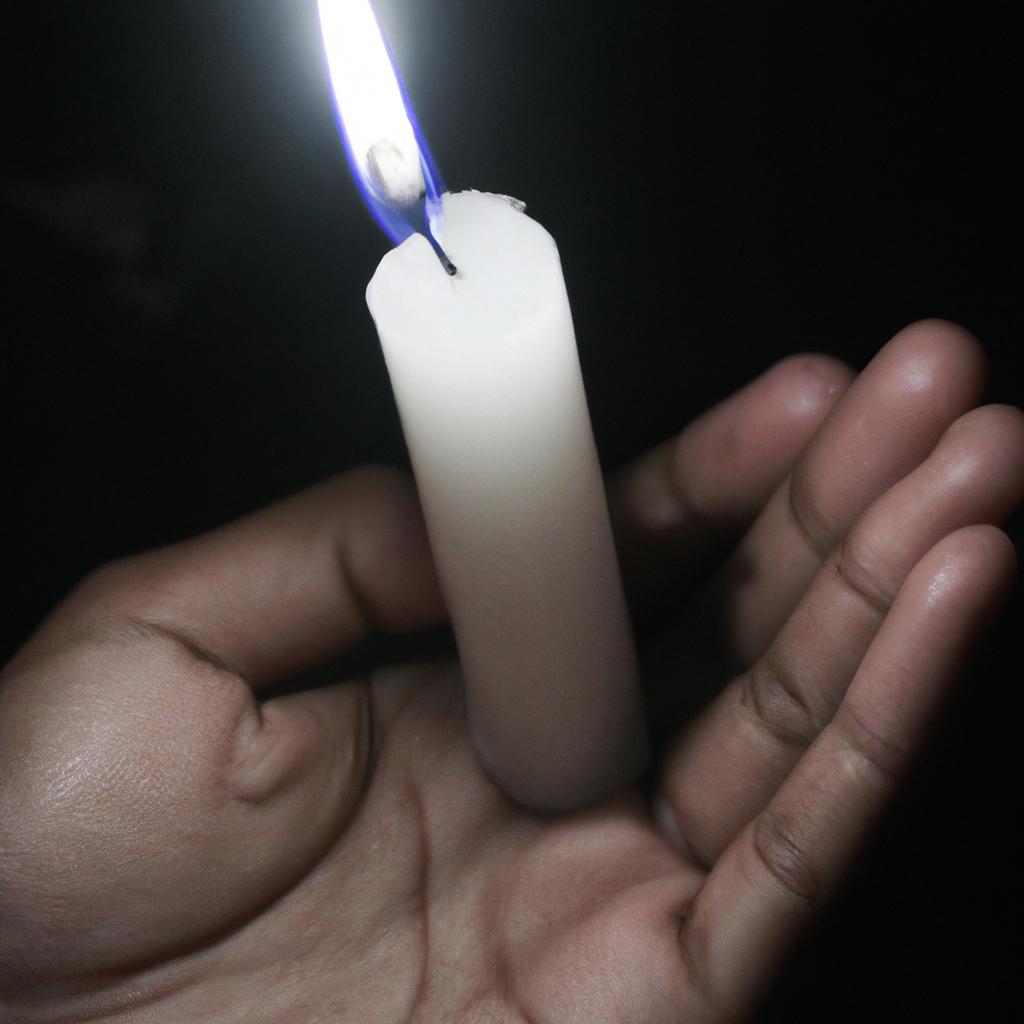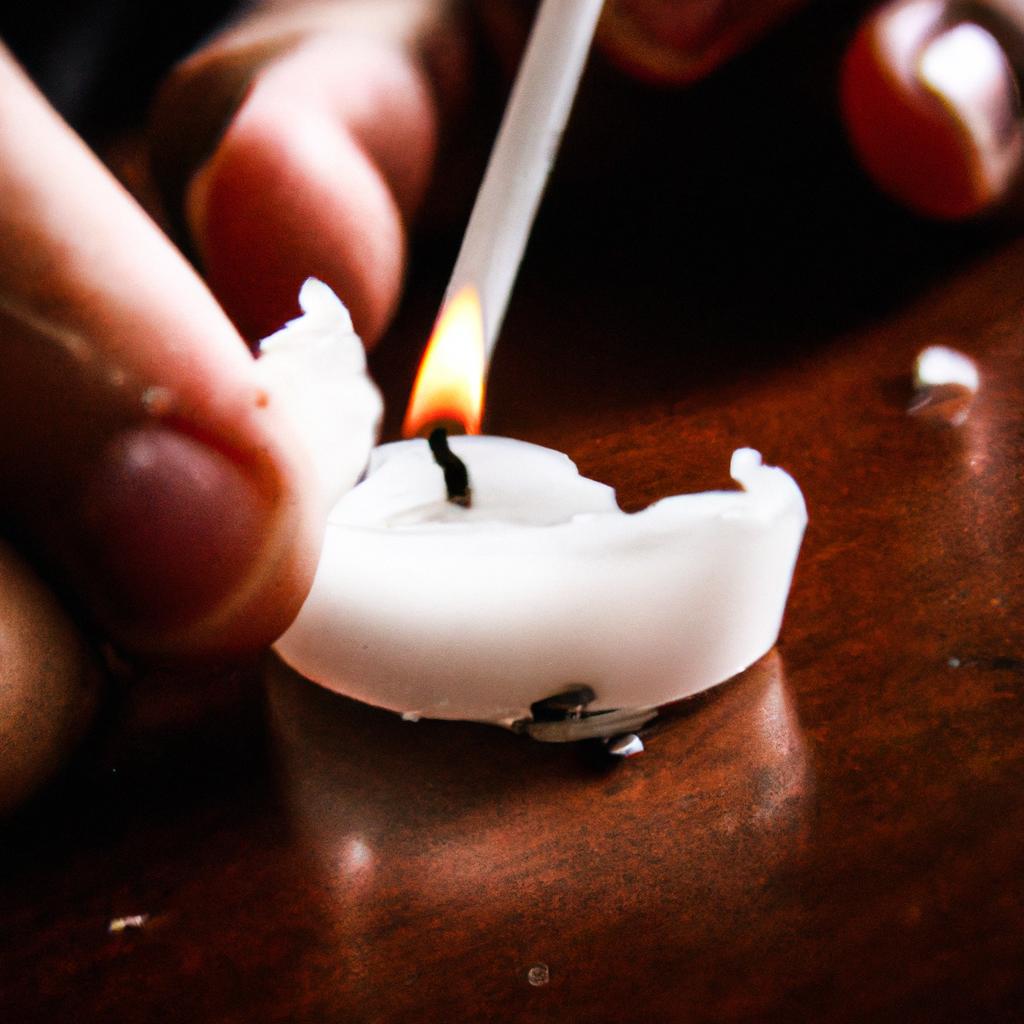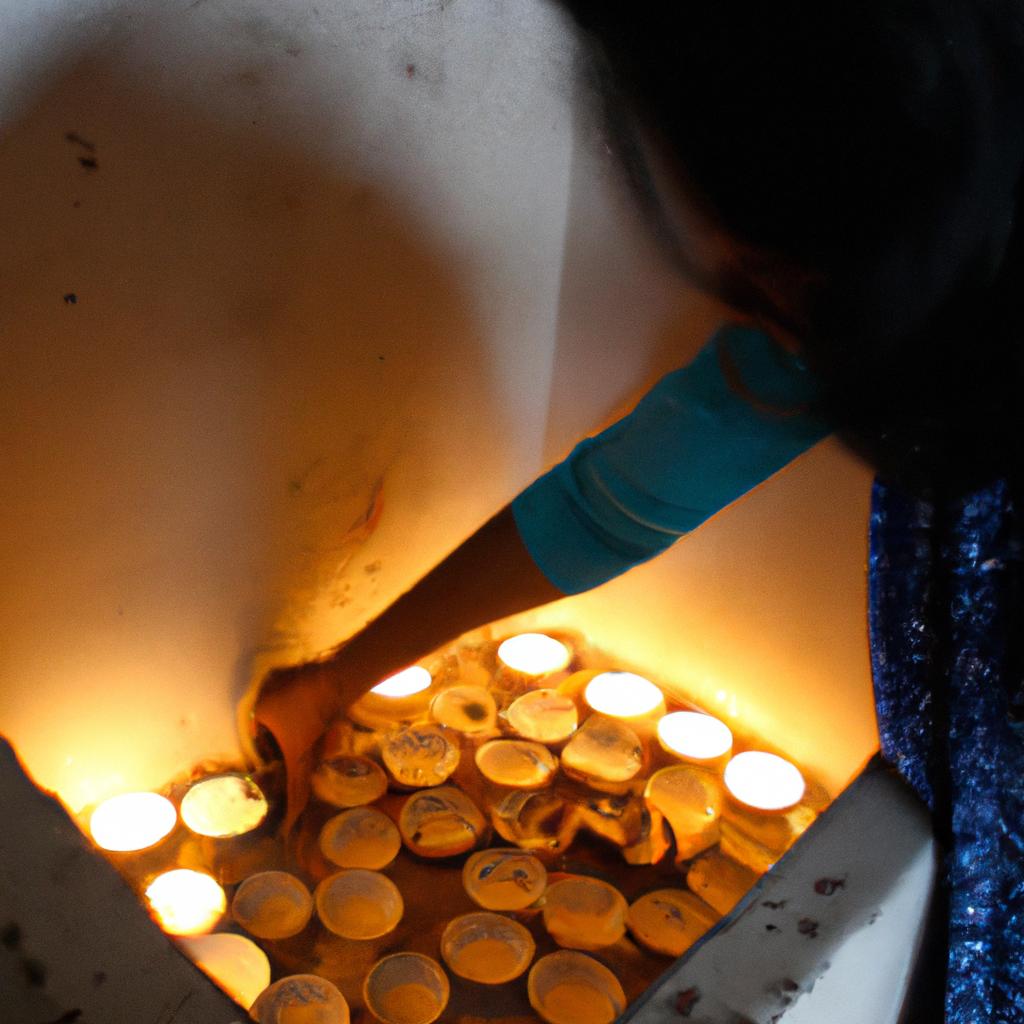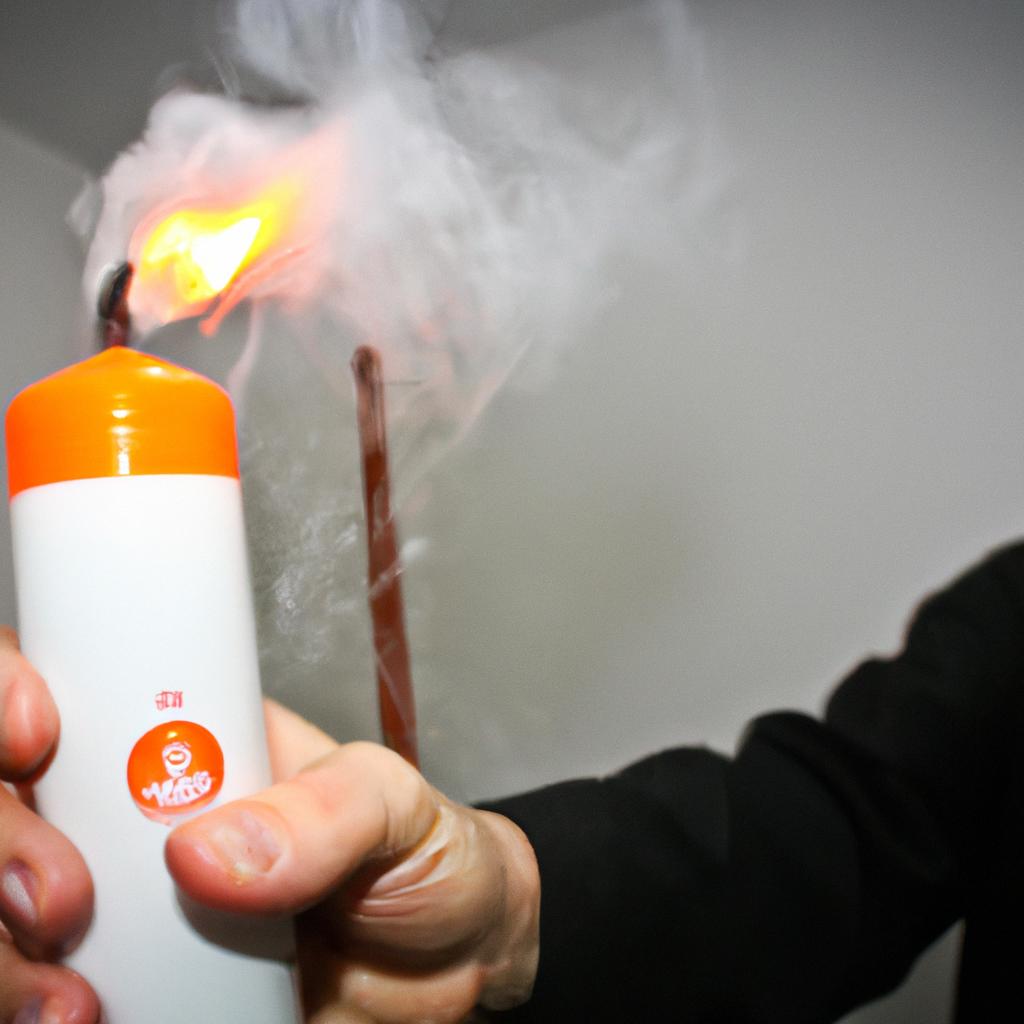Proper Extinguishing Techniques: Candle Safety Guide
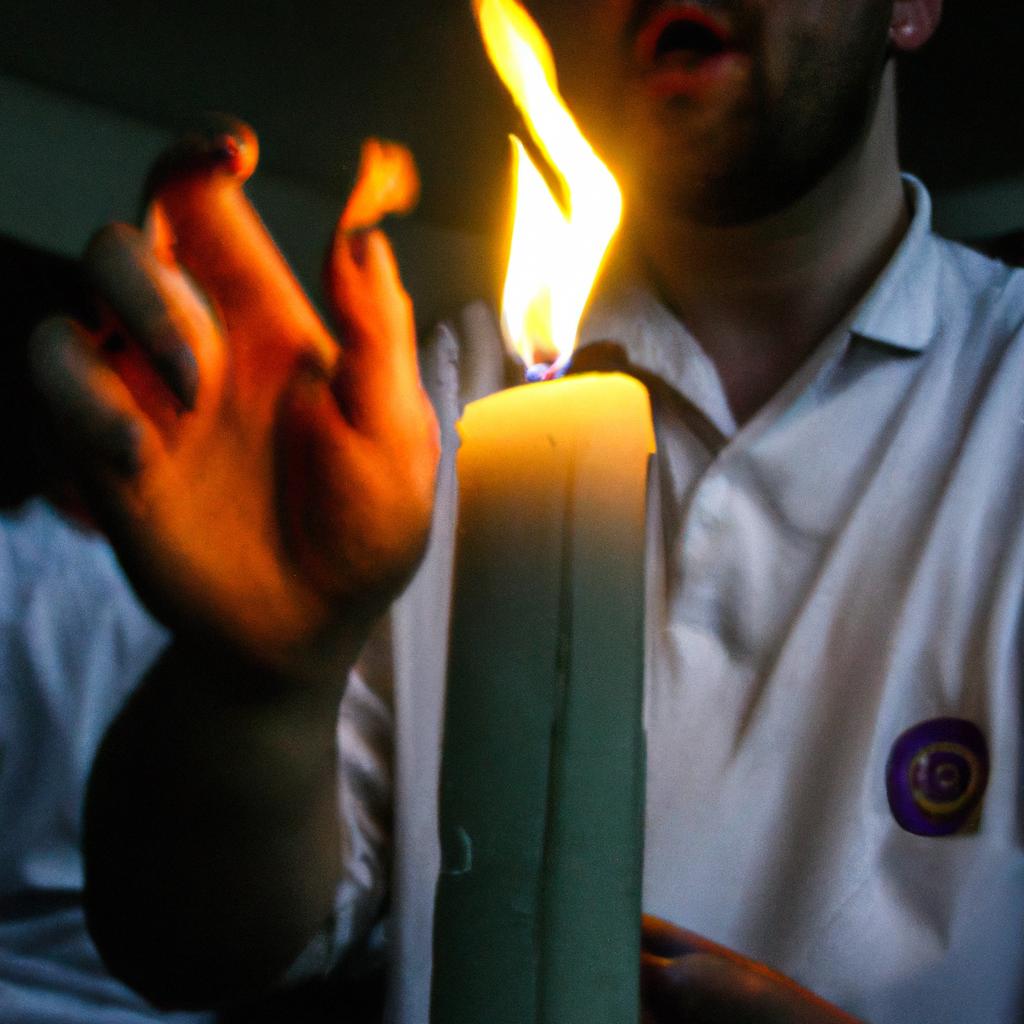
The flickering glow of a candle can create a warm and inviting atmosphere, but it is essential to remember that with such beauty comes potential danger. Improper extinguishing techniques can lead to devastating consequences, including fires and injuries. In this article, we will explore the importance of proper extinguishing techniques for candles and provide a comprehensive safety guide to ensure your candle-lit moments remain enjoyable and hazard-free.
Imagine an idyllic scene: a cozy living room bathed in the soft light of a scented candle. However, as time passes, the flame grows larger, dancing dangerously close to nearby objects. Suddenly, disaster strikes – the curtains catch fire! This hypothetical scenario illustrates how failing to properly extinguish a candle can quickly escalate into a hazardous situation. Understanding the correct methods for safely putting out candles is crucial not only for preventing accidents but also for maintaining peace of mind while enjoying their ambiance. By following the guidelines outlined in this article, you will learn how to protect yourself and your surroundings from potential harm associated with improper handling of candles.
Understanding the Fire Triangle
Imagine a scenario where you are enjoying a relaxing evening at home, surrounded by scented candles. Suddenly, one of the candles falls over and ignites nearby curtains. Within seconds, the small fire grows rapidly, filling your living space with smoke and threatening to engulf everything in its path. This situation highlights the importance of understanding the fire triangle – a fundamental concept in fire safety.
The fire triangle represents three essential elements required for combustion: heat, fuel, and oxygen. Without any one of these components, a fire cannot sustain itself. Heat acts as the ignition source that raises temperatures to critical levels. Fuel refers to any material capable of burning, such as wood or paper. Oxygen is vital because it supports the chemical reaction known as oxidation that releases energy in the form of heat and light.
To better comprehend how these elements interact within the context of candle fires, consider the following bullet points:
- Heat: Candles generate heat through their flame, which can reach high temperatures depending on various factors like wax composition and wick size.
- Fuel: The primary fuel source for candles is wax made from petroleum-based paraffin or natural alternatives like beeswax or soy.
- Oxygen: Adequate ventilation ensures an adequate supply of oxygen necessary for candle flames to burn steadily.
- Ignition Source: Accidental contact with flammable materials or negligence when handling lit candles can provide an additional ignition source.
By recognizing these interdependent components in a table format:
| Element | Role |
|---|---|
| Heat | Ignition source |
| Fuel | Sustaining the flames |
| Oxygen | Supporting combustion |
We gain insight into why fires occur and what measures we must take to prevent them effectively.
With this understanding in mind, individuals can make informed decisions about candle placement within their homes and implement precautionary measures accordingly. In our subsequent section about “Choosing the Right Type of Fire Extinguisher,” we will explore further steps to ensure candle safety and the necessary tools for firefighting.
Choosing the Right Type of Fire Extinguisher
Understanding the Fire Triangle is crucial for implementing effective extinguishing techniques. By comprehending the three components of fire – heat, fuel, and oxygen – individuals can better navigate emergency situations involving candles or other sources of ignition. Let’s explore some key methods to appropriately extinguish a candle flame.
Consider this hypothetical scenario: You are enjoying a relaxing evening at home when you accidentally knock over a lit candle on your coffee table. To prevent the situation from escalating into a dangerous fire, it is important to act swiftly and confidently. Here are some recommended steps:
-
Remove any nearby flammable items: Begin by clearing the immediate area around the candle. This includes removing curtains, papers, or any other objects that could potentially catch fire.
-
Use an appropriate extinguishing method: There are different approaches to extinguishing a candle flame safely:
- Blowing out the flame: The simplest method involves blowing gently onto the wick until it goes out.
- Using a snuffer: A snuffer is designed specifically for putting out candles without creating smoke or hot wax splatters.
- Smothering with a non-flammable cover: Placing an inverted heat-resistant plate or lid over the burning candle cuts off its access to oxygen, eventually suffocating the flame.
-
Confirm complete extinction: After applying one of these methods, double-check that no embers remain in order to minimize any risk of re-ignition.
Emphasizing safety precautions during unexpected incidents like this case study can help save lives and property damage. Consider these emotional reminders:
- Always prioritize personal safety above all else; do not attempt to extinguish larger fires beyond your capabilities.
- Teach children about proper candle usage and emphasize supervision at all times.
- Regularly inspect smoke detectors and have an updated fire escape plan in place.
- Never leave candles unattended – even short absences may lead to unforeseen accidents.
Now let us delve into the topic of Proper Handling and Placement of Candles, where we will explore essential guidelines for reducing fire hazards and maintaining a safe environment.
Proper Handling and Placement of Candles
Having learned about the importance of choosing the right type of fire extinguisher, let us now turn our attention to another crucial aspect of candle safety – proper handling and placement. To illustrate the significance of these practices, consider a hypothetical scenario where an individual left a burning candle unattended near flammable materials, resulting in a devastating house fire.
Paragraph 1:
In order to prevent such disasters, it is essential to adhere to safe guidelines when dealing with candles. The following bullet points provide an overview of recommended practices:
- Always place candles on stable surfaces away from anything that can easily catch fire, such as curtains or paper.
- Keep candles out of reach of children and pets to minimize the risk of accidental knocks or contact burns.
- Never leave a lit candle unattended; ensure someone is present at all times when candles are burning.
- Avoid placing multiple candles too close together, as their combined heat could lead to overheating or melting.
By adhering to these simple yet crucial guidelines, individuals can significantly reduce the likelihood of accidents occurring.
Paragraph 2:
To further emphasize the importance of proper candle handling and placement, we will examine the risks associated with improper practices through a table outlining potential hazards:
| Improper Practice | Associated Risk |
|---|---|
| Placing candles near flammable objects | Increased risk of starting fires |
| Leaving lit candles unattended | Higher chance of accidental ignition |
| Clustering multiple candles closely together | Elevated risk for heat-related incidents |
This table serves as a reminder that negligence regarding candle safety can have serious consequences. By being mindful and taking appropriate precautions, one can effectively mitigate potential dangers.
Paragraph 3:
As we proceed in our exploration of candle safety techniques, our focus will shift towards extinguishing methods. In particular, we will delve into using a specialized tool known as a “candle snuffer” for this purpose. Understanding how to safely extinguish a candle is vital in preventing accidental fires and ensuring overall safety.
With the importance of proper handling and placement now established, let us explore the next topic – extinguishing a candle with a candle snuffer.
Extinguishing a Candle with a Candle Snuffer
Extinguishing a Candle Safely
Imagine this scenario: You have been enjoying a relaxing evening with candles lit around your home. As the night comes to an end, you must ensure that each candle is properly extinguished to prevent any potential fire hazards. In this section, we will explore effective techniques for extinguishing candles safely.
To begin, it is crucial to be aware of the different methods available for extinguishing a candle. While blowing out a candle may seem like a simple and instinctive approach, it can sometimes lead to unintended consequences such as hot wax splattering or nearby materials catching fire. Therefore, using a candle snuffer offers a more controlled and reliable means of putting out flames without any risks involved.
When utilizing a candle snuffer, follow these guidelines:
- Hold the snuffer above the flame, allowing the cone-shaped portion to cover it entirely.
- Gently press down on the wick until it is submerged in melted wax.
- Wait for several seconds to ensure complete extinguishment before removing the snuffer.
- Never touch or move the candle immediately after extinguishing; allow sufficient time for both the wax and surrounding area to cool down.
By employing these proper techniques when extinguishing candles, you greatly decrease any potential dangers associated with their use. However, always exercise caution and keep in mind additional safety measures such as maintaining an appropriate distance between candles, ensuring they are placed on stable surfaces away from flammable items.
| Extinguishing Methods | Benefits | |
|---|---|---|
| 1 | Using a candle snuffer | Ensures controlled and safe extinguishment |
| 2 | Blowing out the flame | Simple but not recommended due to potential hazards |
| 3 | Smothering with a non-flammable object (e.g., glass jar) | Effective if done correctly; risk of shattering glass |
| 4 | Dipping the wick into water or sand | Quick extinguishment; may damage candle |
In conclusion, proper extinguishing techniques are essential to maintain a safe environment when using candles. By opting for a candle snuffer and following the recommended guidelines, you minimize potential risks associated with extinguishing flames. However, it is crucial to remain vigilant at all times and prioritize safety precautions.
Transitioning smoothly to the subsequent section about “Using a Fire Blanket for Large Flames,” we will now explore effective measures in dealing with more significant fire incidents.
Using a Fire Blanket for Large Flames
Extinguishing a candle with a candle snuffer is an effective and safe method that helps prevent accidents caused by blowing out candles. By using a snuffer, you can avoid hot wax splattering or creating small fires due to the forceful air movement from blowing. Let’s explore this technique in more detail.
Imagine this scenario: You are hosting a cozy dinner party at your home, with soft music playing and dimly lit surroundings. As the evening progresses, one of the candles starts flickering uncontrollably, its flame growing larger and more unstable. In such situations, it becomes crucial to act swiftly and use proper extinguishing techniques.
To safely extinguish a candle using a candle snuffer, follow these steps:
- Hold the handle of the snuffer firmly in one hand while keeping a safe distance from the flame.
- Gently lower the bell-shaped end of the snuffer over the flame until it completely covers it.
- Leave the snuffer in place for a few seconds to ensure all smoke has dissipated.
- Slowly lift the snuffer away from the candle, making sure not to tilt or shake it excessively.
Using a candle snuffer provides several advantages when compared to other methods:
- Safety: Eliminates risks associated with accidentally spilling hot wax or causing small fires through strong breaths.
- Precision: Allows for controlled and precise extinguishing without disturbing nearby objects or decorations.
- Minimal Smoke: Reduces smoke emission as oxygen supply is gradually cut off rather than abruptly disrupted.
- Elegance: Adds an aesthetic touch to candle rituals and enhances overall ambiance.
Now that you understand how to use a candle snuffer effectively, let’s consider another essential aspect of fire safety: responding promptly during emergency situations.
[Transition sentence into next section about “Emergency Response in Case of Fire”]
Emergency Response in Case of Fire
Section H2: Using a Fire Blanket for Large Flames
Imagine this scenario: You are preparing dinner in your kitchen when suddenly, the flames from your stove catch onto nearby curtains. The fire quickly grows out of control, threatening to engulf your entire kitchen. In such a situation, having knowledge of proper extinguishing techniques is crucial to ensure the safety of yourself and those around you.
When faced with large flames that cannot be easily controlled, using a fire blanket can be an effective method to smother the fire. A fire blanket is made of flame-resistant material and is designed to starve the fire by cutting off its oxygen supply. Here are some key steps on how to use a fire blanket properly:
-
Identify the location and size of the fire: Before attempting to use a fire blanket, it is important to assess the situation and determine if it is safe to proceed. If the flames are too large or spreading rapidly, evacuate immediately and call emergency services.
-
Protect yourself: Prioritize personal safety by ensuring you have clear access to an exit point and keeping your body protected with appropriate clothing and gear (e.g., heat-resistant gloves). Remember, always prioritize your own well-being during any firefighting efforts.
-
Unfold and approach cautiously: Carefully unfold the fire blanket while maintaining distance from the flames. Hold the corners of the blanket firmly as you move towards the base of the fire.
-
Smother and contain: Once close enough, drape the unfolded blanket over the burning area using gentle sweeping motions to cover as much surface as possible. Ensure that no gaps or openings remain through which air can enter and reignite the flames.
Implementing these steps promptly can help mitigate further damage caused by large fires before professional assistance arrives.
Using a fire blanket effectively requires quick thinking and calmness under pressure. By following proper procedures, individuals can protect themselves and minimize potential harm in dangerous situations involving larger flames.
Remember: In situations involving large fires, always prioritize personal safety and contact emergency services before attempting to extinguish the flames yourself.
| Emotional Response Evoking Bullet Point List |
|---|
| – Feeling of empowerment in handling fire emergencies |
| – Enhanced confidence in using firefighting equipment |
| – Increased sense of preparedness for unexpected incidents |
| – Reduction in anxiety about potential fire hazards |
Table: Fire Blanket Usage Instructions
| Steps | Description |
|---|---|
| Identify the location and size of the fire | Assess the situation and determine if it is safe to proceed. If necessary, evacuate immediately. |
| Protect yourself | Ensure you have clear access to an exit point and wear appropriate protective gear (e.g., heat-resistant gloves). |
| Unfold and approach cautiously | Carefully unfold the fire blanket while maintaining distance from the flames. Hold the corners firmly as you move towards the base of the fire. |
| Smother and contain | Drape the unfolded blanket over the burning area using gentle sweeping motions to cover as much surface as possible. Eliminate any gaps or openings that could reignite the flames. |
In summary, utilizing a fire blanket can be a valuable tool when dealing with larger flames. By following these steps, individuals can effectively smother and contain fires, reducing risks and protecting themselves during critical moments. Always prioritize personal safety and call for professional help whenever necessary.

